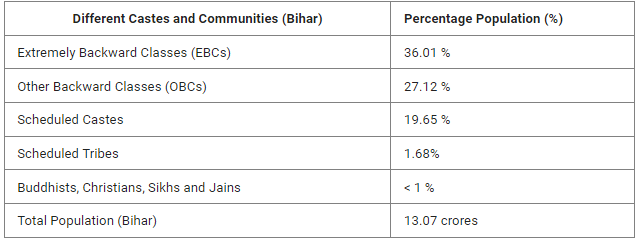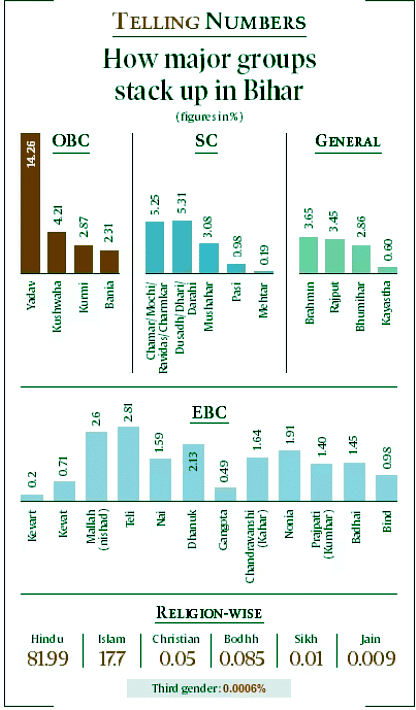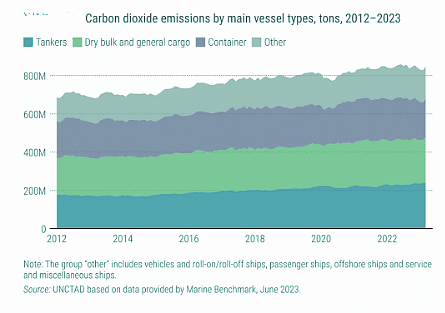Weekly Current Affairs (1st to 7th October 2023) Part - 1 | General Test Preparation for CUET UG - CUET Commerce PDF Download
| Table of contents |

|
| Nobel Prize in Medicine 2023 |

|
| Global Innovation Index 2023 |

|
| Mahatma Gandhi’s 154th Birth Anniversary |

|
| Caste-Census in Bihar |

|
| Review of Maritime Transport 2023: UNCTAD |

|
Nobel Prize in Medicine 2023
Context: The Nobel Prize in Medicine or Physiology for 2023 has been awarded to Katalin Karikó and Drew Weissman for their groundbreaking work on nucleoside base modification of messenger Ribonucleic Acid (mRNA).
- The discoveries by the two Nobel Laureates were critical for developing effective mRNA vaccines against Covid-19 during the pandemic that began in early 2020.
What Did Katalin Karikó and Drew Weissman Discover?
Understanding the Challenge:
- Cells possess an inherent capability to detect foreign materials. Dendritic cells, which play a crucial role in our immune system, had the ability to recognize in vitro transcribed mRNA as foreign, setting off an inflammatory response.
- This reaction could potentially lead to harmful side effects and undermine the vaccine's efficacy.
- Furthermore, another challenge stemmed from the fact that in vitro transcribed mRNA was highly unstable and susceptible to degradation by enzymes within the body.
Note
- In vitro transcribed mRNA is a type of synthetic RNA that is produced in the laboratory by using a DNA template and an RNA polymerase.
- It can be used for various purposes, such as making RNA probes, vaccines, or proteins.
Katalin Karikó and Drew Weissman’s Discovery:
- Karikó and Weissman observed that dendritic cells identify in vitro transcribed mRNA as foreign, activating them and causing the release of inflammatory signals.
- They questioned why this mRNA was considered foreign, unlike mRNA from mammalian cells, which didn't trigger the same response.
- Mammalian cells are eukaryotic cells that belong to the animal kingdom and have a nucleus and other membrane-bound organelles.
- This led them to realize that there must be distinct properties separating the two mRNA types.
The Breakthrough:
- RNA, like Deoxyribonucleic acid (DNA), consists of four bases: A, U, G, and C. Karikó and Weissman noticed that natural RNA from mammalian cells often had chemical modifications in its bases.
- They hypothesized that the absence of these modifications in lab-made mRNA might cause inflammatory reactions.
- To test this, they created various mRNA variants with unique chemical alterations and delivered them to dendritic cells. Their results showed a significant reduction in inflammatory responses when base modifications were included in the mRNA.
- This discovery transformed our understanding of how cells recognize and respond to different types of mRNA, with profound implications for mRNA's therapeutic potential.
- Their subsequent studies in 2008 and 2010 demonstrated that mRNA with base modifications led to increased protein production.
- This effect was attributed to the reduced activation of an enzyme involved in protein production.
- Karikó and Weissman's research removed critical obstacles, making mRNA more suitable for clinical applications.
Application of Base-modified mRNA Vaccines:
- Interest in mRNA technology grew, and by 2010, several companies were actively developing this method for various purposes.
- Initially pursued for vaccines against diseases like Zika virus, which is closely related to SARS-CoV-2.
- With the onset of the Covid-19 pandemic, base-modified mRNA vaccines encoding the SARS-CoV-2 surface protein were developed at an unprecedented pace.
- These vaccines demonstrated protective effects of approximately 95% and received approval as early as December 2020.
- The remarkable flexibility and speed of mRNA vaccine development opened doors to potential use against other infectious diseases.
- Collectively, more than 13 billion Covid-19 vaccine doses have been administered worldwide, saving millions of lives and preventing severe illness.
- This transformative development during a major health crisis highlights the critical role played by this year's Nobel laureates in recognizing the importance of base modifications in mRNA.
What are mRNA Vaccines and How do they Work?
- mRNA stands for messenger RNA, a molecule that carries genetic information from DNA to the protein-making machinery of the cell.
- mRNA vaccines use synthetic mRNA that encodes a specific protein from a pathogen, such as the spike protein of the coronavirus.
- When the mRNA vaccine is injected into the body, some of the cells take up the mRNA and use it to produce the protein. The protein then triggers an immune response that produces antibodies and memory cells that can recognize and fight the pathogen in the future.
- mRNA vaccines are faster and cheaper to produce, as they do not require cell culture or complex purification processes.
- mRNA vaccines are also more flexible and adaptable, as they can be easily modified to target new variants or strains of pathogens.
Global Innovation Index 2023
Context: India retains 40th rank out of 132 economies in the Global Innovation Index 2023 rankings published by the World Intellectual Property Organization (WIPO).
- The 2023 edition reveals the ranking of this year’s most innovative economies in the world amongst 132 economies and localizes the top 100 science and technology innovation clusters.
Note: GII is a leading reference for measuring an economy’s innovation ecosystem performance. Published annually, it is also a valuable benchmarking tool used by policymakers, business leaders, and other stakeholders to assess progress in innovation over time.
What is WIPO?
- WIPO is the global forum for Intellectual Property (IP) services, policy, information and cooperation.
- It is a self-funding agency of the United Nations, with 193 member states.
- Its aim is to lead the development of a balanced and effective international IP system that enables innovation and creativity for the benefit of all.
- Its mandate, governing bodies and procedures are set out in the WIPO Convention, which established WIPO in 1967.
What are the Key Highlights of the Index?
Most Innovative Economies in 2023:
- Switzerland is the most innovative economy in 2023 followed by Sweden, the United States, the United Kingdom and Singapore.
- Singapore has entered the top five, and has taken the leading position among South East Asia, East Asia and Oceania (SEAO) region economies.
Top Science and Technology (S&T) Clusters in the World:
- The top Science and Technology innovation clusters in the world in 2023 are Tokyo–Yokohama, followed by Shenzhen–Hong Kong–Guangzhou, Seoul, Beijing and Shanghai-Suzhou.
- S&T clusters are the areas in the world where the highest density of inventors and scientific authors are located.
- China now has the largest number of clusters in the world, overtaking the United States.
What are the Key Highlights Related to India?
Overall Ranking and Growth:
- India secured the 40th position in the latest GII 2023, showcasing a remarkable climb from the 81th spot in 2015.
- This ascent underscores India's consistent and substantial growth in innovation over the past eight years.
- India secured the top position among the 37 lower-middle-income countries and leading among the 10 economies in Central and South America.
- Key indicators affirmed India's robust innovation landscape, including significant rankings in ICT services exports, venture capital received, graduates in science and engineering, and global corporate R&D investors.
S&T Clusters:
- Compared to China’s 24 and US’s 21, India has only 4 S&T clusters among the world’s top 100. These are Chennai, Bengaluru , Mumbai and Delhi.
India’s Progress:
- India’s progress is attributed to its abundant knowledge capital and a thriving Startup Ecosystem, along with commendable efforts from public and private research organizations.
- The Covid-19 pandemic emphasized the vital role of innovation in addressing challenges, aligning with the nation's vision of Atma Nirbhar Bharat (Self-reliant India).
Need for Improvement:
- Certain areas necessitate improvement, particularly infrastructure, business sophistication, and institutions.
- To bridge these gaps, NITI Aayog is actively working to promote policy-led innovation in crucial sectors such as electric vehicles, biotechnology, nanotechnology, space, and alternative energy sources.
Mahatma Gandhi’s 154th Birth Anniversary
Context: On 2nd October,2023, Mahatma Gandhi’s 154th birth anniversary was celebrated across the nation to commemorate his principles and ideals that inspire the nation until the present times, owing to the indispensable role played by him during the freedom struggle.
- His contributions to the freedom struggle earned him the epithet of “Father of Nation” which led to his portrait being featured on Indian legal banknotes.
- Being a multi-faceted personality, Mahatma Gandhi had deep interest in music, and he always promoted safeguarding the environment.
How did Mahatma Gandhi Become a Permanent Feature on Legal Banknotes of India?
The Origins of Gandhi’s Image on Indian currency:
- The portrait of Gandhi visible on banknotes is a cut-out of a photograph taken in 1946, where he is standing with British politician Lord Frederick William Pethick-Lawrence.
- The photograph was selected as it had the most suitable expression of Gandhi smiling — the portrait is a mirror image of the cut-out.
- According to Section 25 of the RBI Act, 1934, “the design, form and material of banknotes” shall be such as may be approved by the central government after consideration of the recommendations made by the central board.
Gandhi’s First Appearance on INR notes:
- Gandhi first featured on Indian currency in 1969, when a special series was issued to commemorate his 100th birth anniversary.
- Then, in October 1987, a series of Rs 500 currency notes, featuring Gandhi, was launched.
- Gandhiji, a Permanent Feature on Banknotes:
- Gandhi was chosen because of his national appeal, and in 1996, a new ‘Mahatma Gandhi Series’ was launched by the RBI to replace the former Ashoka Pillar bank notes.
- Several security features were also introduced, including a windowed security thread, latent image and intaglio features for the visually impaired.
What are Mahatma Gandhi’s Lessons on Sustainability?
Simplicity and Minimalism:
- Gandhi advocated for a simple and minimalist lifestyle. He believed that individuals should live with the bare minimum and avoid excessive consumption.
- This idea of simple living, or "Sarvodaya," promotes the conservation of resources and a reduced ecological footprint.
Self-Sufficiency:
- Gandhi emphasized the importance of self-sufficiency at the community level. He promoted the idea of villages being self-reliant in terms of food, clothing, and other basic needs.
- This approach reduces dependence on external resources and minimizes environmental impacts associated with long-distance transportation and trade.
Nonviolence (Ahimsa):
- Gandhi's principle of nonviolence extends beyond human relations to encompass all living beings and the environment. He believed in the ethical treatment of animals and was a vegetarian himself.
- This reflects his concern for the well-being of all creatures and the importance of coexisting harmoniously with nature.
Sustainable Agriculture:
- Gandhi supported sustainable and organic farming practices. He advocated for the use of natural fertilizers, crop rotation, and traditional farming methods that preserve soil fertility and reduce the need for chemical inputs.
Conservation of Resources:
- Gandhi emphasized the responsible use and conservation of natural resources, such as water and forests.
- He believed in protecting and regenerating the environment to ensure that future generations have access to these resources.
Localism and Decentralization:
- Gandhi was a proponent of decentralization of power and resources. He believed in devolving authority to local communities, which can be more attuned to their own environmental and sustainability needs.
- Swadeshi:
- Gandhi promoted the Swadeshi movement, which encouraged the use of locally produced goods and materials.
- This concept aimed to reduce the ecological impact of long-distance trade and promote local economies.
Respect for Nature:
- Gandhi believed that humans should have a deep respect and reverence for nature.
- He saw nature as an essential part of human life and called for responsible stewardship of the environment.
Vasudhaiva Kutumbakam:
- His belief in Vasudev Kutumbakam (the entire world is one family) encourages us to believe that we all are citizens of one world, and that we must remain conscious of global issues.
- What is the Relationship of Mahatma Gandhi’s Idea of Politics with Music?
Bhajans and Religious Music:
- Gandhi had a strong spiritual side, and he often used devotional music, such as bhajans (Hindu religious songs), as a means of connecting with his inner self and finding solace.
- He believed that singing hymns and religious songs helped purify the mind and strengthen one's connection with the divine.
Inspirational Songs:
- Gandhi encouraged the use of inspirational songs and patriotic songs to unite people in the struggle for independence.
- Songs like "Raghupati Raghava Raja Ram" and "Vaishnav Jan To" were among his favorites and were frequently sung during his prayer meetings and public gatherings.
Fasting and Silence:
- Gandhi sometimes observed periods of fasting and silence as a form of protest or self-purification.
- During these times, he often communicated with others through written messages and used music to convey his thoughts and feelings.
Community Bonding:
- Music played a crucial role in bringing communities together during Gandhi's nonviolent movements.
- Chants, songs, and music created a sense of unity and solidarity among the participants in various campaigns, such as the Salt March.
Promotion of Folk Music:
- Gandhi was a proponent of traditional Indian culture and believed in the preservation of folk music and arts.
- He encouraged the use of local languages and music to connect with the masses, as he believed that they were more relatable and accessible.
Role in Nonviolent Resistance:
- Music was an integral part of the nonviolent resistance movements led by Gandhi. It served as a means of inspiring and mobilizing people, fostering a sense of collective identity, and uplifting spirits during challenging times.
Advocacy for Simplicity:
- Gandhi's philosophy of simplicity and minimalism extended to music. He preferred simple and melodious tunes that could be easily understood and appreciated by the common people.
Caste-Census in Bihar
Context: Recently, the Government of the State of Bihar released findings of the Caste Survey, 2023 which revealed that Other Backward Classes (OBCs) and Extremely Backward Classes (EBCs) together constitute 63 % of the state’s total population.
- The findings are supposed to have wider connotations in the State and National Elections and also in the identification of intended beneficiaries for various welfare schemes.
What are the Key Findings of the Bihar Caste Survey?


What was the procedure adopted in the Caste Survey?
The survey was carried out in two phases, which each had its own criteria and objectives.
First Phase:
- During this phase, the number of all households in Bihar were counted and recorded.
- Enumerators were given a set of 17 questions which were to be mandatorily answered by the respondent.
Second Phase:
- During this phase data on people living in the households, their castes, sub-castes, and socio-economic conditions were collected.
- However, filling the Aadhaar number, caste certificate number and ration card number of the head of the family, were optional.
What is the Significance of the Bihar Caste Survey Findings?
Increasing the OBC Quota:
- The survey results will amplify the clamour for increasing the OBC quota beyond 27%, and for a quota within quota for the EBCs.
- The Justice Rohini Commission, which has been examining the question of sub-categorisation of OBCs since 2017, submitted its report and recommendations are not yet made public.
Redrawing of 50% Reservation Ceiling:
- The survey data will also reopen the debate over the 50% ceiling on reservation imposed by the Supreme Court in its landmark ruling in Indra Sawhney v Union of India (1992).
- Depending upon the population of OBCs, the demand for increase in reservation quota in proportion to that of the population can arise from different quarters of the caste groups.
Fulfilment of Constituional Obligations:
- Caste Survey will help attain the objectives as enunciated in Directive Principles of State Policies (DPSPs) as mentioned in Part IV of the constitution.
- This will majorly help achieve the socio-economic objectives as outlined by the Constitution drafters.
Realisation of Sarvodaya:
- Caste Census can be properly utilised to develop targeted measures so as to reduce rampant inequality across the State and promote equity and social justice In the long term.
What are the Issues With the Caste Census?
Repercussions of a Caste Census:
- Caste has an emotive element and thus there exist the political and social repercussions of a caste census.
- There have been concerns that counting caste may help solidify or harden identities.
- Due to these repercussions, nearly a decade after the SECC, a sizable amount of its data remains unreleased or released only in parts.
Caste is Context-specific:
- Caste has never been a proxy for class or deprivation in India; it constitutes a distinct kind of embedded discrimination that often transcends class.
For example:
- People with Dalit last names are less likely to be called for job interviews even when their qualifications are better than that of an upper-caste candidate.
- They are also less likely to be accepted as tenants by landlords.
- Marriage to a well-educated, well-off Dalit man still sparks violent reprisals among the families of upper-caste women every day across the country.
When was the last Caste Census Conducted in India?
Caste Census of 1931:
- The last caste census was conducted in 1931, and data was made publicly available by the British Government of the day.
- This caste census became the basis for the implementation of Mandal Commission Reports and subsequent reservation policies by the government for Other Backward Classes.
Census of 2011:
- The Census of 2011 became the first time to collect Caste-based data after independence.
- However, the data related to caste were not made public due to fear of political favouritism and opportunism.
What is the Census?
Origin of Census:
- The origin of the Census in India goes back to the colonial exercise of 1881.
- Census has evolved and been used by the government, policymakers, academics, and others to capture the Indian population, access resources, map social change, delimitation exercise, etc.
First Caste Census as SECC (Socio-Economic and Caste Census):
- SECC was conducted for the first time in 1931.
- SECC is meant to canvass every Indian family, both in rural and urban India, and ask about their:
- Economic status, so as to allow Central and State authorities to come up with a range of indicators of deprivation, permutations, and combinations of which could be used by each authority to define a poor or deprived person.
- It is also meant to ask every person their specific caste name to allow the government to re-evaluate which caste groups were economically worse off and which were better off.
Difference Between Census & SECC:
- The Census provides a portrait of the Indian population, while the SECC is a tool to identify beneficiaries of state support.
- Since the Census falls under the Census Act of 1948, all data are considered confidential, whereas according to the SECC website, “all the personal information given in the SECC is open for use by Government departments to grant and/or restrict benefits to households.”
Review of Maritime Transport 2023: UNCTAD
Context: Recently, the United Nations Conference on Trade and Development (UNCTAD) has released the Review of Maritime Transport 2023, highlighting the Issue of Greenhouse Gas (GHG) Emissions from International Shipping and Challenges in Decarbonization.
What are the Key Highlights of the Review?
Emissions from International Shipping:
- GHG emissions from international shipping were 20% higher in 2023 compared to a decade ago.
- The shipping industry contributes to over 80% of the world’s trade volume and nearly 3% of global GHG emissions.

Growth in Shipping Volume:
- Global maritime shipping volumes experienced a 0.4% drop in 2022 due to disruptions in global supply chains caused by Covid-19.
- However, it is projected to grow by 2.4% in 2023.
- Containerized trade is expected to grow by 1.2% in 2023 and further by 3% between 2024-2028.
- Oil and gas trade volumes showed robust growth in 2022.
Non-Availability of Alternative Fuels:
- Early in January 2023, commercial ships were on average 22.2 years old and more than half of the world’s fleet was over 15 years old.
- As the average age of the world fleet is increasing, it raises concern that alternative fuels are not yet available at scale and are more costly, and the ships that can use them are also more costly than traditional ships.
Transitioninig to Alternative Fuels:
- It is very difficult for ship owners to renew their fleet without clarity on technology and regulatory regimes, and port terminals also face similar challenges, particularly with regard to investment decisions.
- 98.8% of the global fleet uses conventional fuels like heavy fuel oil, light fuel oil, and diesel/gas oil.
- Only 1.2% are using alternative fuels, mainly LNG, LPG, methanol, and to a lesser extent, battery/hybrid.
- However, progress is underway as 21 % of vessels currently on order are designed to run on alternative fuels, notably LNG, LPG, battery/hybrid and methanol.
Cost Estimates and Transition Challenges:
- Decarbonizing the world's fleet by 2050 could require annual investments ranging from USD 8 billion to USD 90 billion.
- Full decarbonization could double yearly fuel costs, necessitating a just transition for the sector.
- IMO (International Maritime Organization) has set a target to achieve net-zero GHG emissions by around 2050.
- The 2023 IMO GHG Strategy aims for at least 5-10% uptake of zero or near-zero GHG fuels by 2030.
What are the UNCTAD's Recommendations for Economic Incentives?
- Renewable ammonia and methanol fuels are seen as more suitable for newer ships with dual-fuel engines.
- Sustainable marine fuels should achieve zero or near-zero carbon dioxide equivalent emissions on a life-cycle 'well-to-wake' basis.
- UNCTAD advocates for system-wide collaboration, swift regulatory intervention and stronger investments in green technologies and fleets.
- Economic incentives, such as levies or contributions related to shipping emissions, can promote the competitiveness of alternative fuels and support investments in climate-resilient infrastructure.
- There is a need to balance environmental goals with economic needs but underscores that the cost of inaction far outweighs the required investments.
- Beyond cleaner fuels, the Shipping industry needs to move faster towards digital solutions like AI and blockchain to improve efficiency as well as sustainability.
What are the Initiative of International bodies to Decarbonize International Shipping?
Energy Efficiency Existing Ship Index (EEXI):
- IMO is revising its existing carbon intensity regulations for ships with EEXI, which limits the technical carbon intensity of the ship by limiting how much carbon dioxide the ship is designed to emit based on its size and ship type, and the Carbon Intensity Indicator (CII), which grades ships from A-E based on their operational carbon intensity, based on how much fuel the ships use each year.
IMO’s Mid-Term Measures:
- Additionally, IMO is developing new regulations called Mid-Term Measures, which will include a technical element, most likely a Greenhouse Gas Fuel Standard (GFS), as well as an economic element, such as a carbon levy, a feebate system, or cap-and-trade.
- The IMO aims to agree on these measures by 2025 and have them enter into force in 2027.
The Green Voyage 2050 Project:
- It is a partnership project between the Government of Norway and IMO launched in May 2019 aiming to transform the shipping industry towards a lower carbon future.
International Convention for the Prevention of Pollution from Ships (MARPOL Convention):
- MARPOL convention is the main international convention covering prevention of pollution of the marine environment by ships from operational or accidental causes.
- The MARPOL Convention was adopted on 2nd November 1973 at IMO.
|
164 videos|628 docs|1133 tests
|















